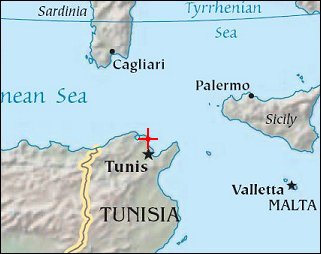| Earth from Space is a free eBook describing our planet from a satellite's perspective. Fore more information, please read the About pages. |

|

Home  Africa Africa  Tunisia Tunisia  Carthage Carthage |
|






|
|
CarthagePosition of center of photo (Lat/Long): [36.85235/10.32656] |
|
  The favorable location of the ancient city of Carthage (Tunisia) is clear in this image. Embayments along the coastline provided ready access to the Gulf of Tunis to the east and southeast. Docks along the coastline (lower right) support the shipping industry. Modern Carthage is a wealthy suburb of the Tunis metropolitan area (the center of which is located to the southwest of the image), as evidenced by dense concentrations of white building rooftops in residential subdivisions to the north and south of the ancient city location. Large tracts of new developments appear to be in progress along the curving, light colored roadways to the southwest of the historical city (lower center). The green shallow waters of an evaporating saline lake are visible at the left. Several such lakes are present in Tunisia and are centers for bird watching-related tourism. The favorable location of the ancient city of Carthage (Tunisia) is clear in this image. Embayments along the coastline provided ready access to the Gulf of Tunis to the east and southeast. Docks along the coastline (lower right) support the shipping industry. Modern Carthage is a wealthy suburb of the Tunis metropolitan area (the center of which is located to the southwest of the image), as evidenced by dense concentrations of white building rooftops in residential subdivisions to the north and south of the ancient city location. Large tracts of new developments appear to be in progress along the curving, light colored roadways to the southwest of the historical city (lower center). The green shallow waters of an evaporating saline lake are visible at the left. Several such lakes are present in Tunisia and are centers for bird watching-related tourism.
Originally a settlement of Phoenician colonists, Carthage grew into a vast economic and political power throughout the Mediterranean Sea, accumulating wealth and influence through its economic (trading) prowess. Carthage was a superpower, contemporaneously with the Roman Republic of the 2nd and 3rd Century BC, and was its rival for dominance of the western Mediterranean. Eventually this rivalry led to a series of three wars known as the Punic Wars, each of which Carthage lost. These losses led to a decline in Carthage's political and economic strength, mostly due to the harsh penalties imposed on Carthage by Rome as conditions of the cessation of hostilities. The Third Punic War ended with the complete destruction of the city of Carthage and the annexation of the last remnants of Carthaginian territory by Rome. Although a distinct Carthaginian civilization ceased to exist, remnants of it contributed to later Mediterranean cultures. |
| Source of material: NASA |
Further information: WikiPedia article on Carthage
Last Update: 2011-03-30

